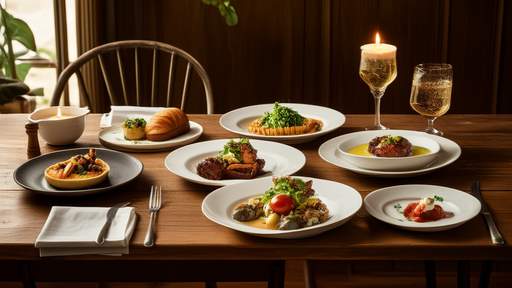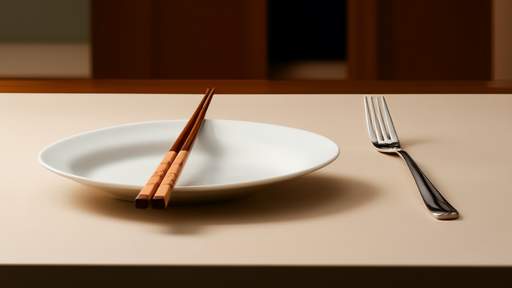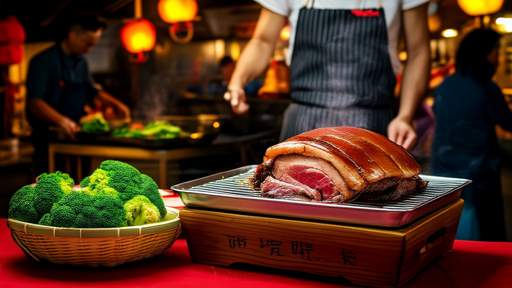In the hushed theater of dining etiquette, few objects carry as much symbolic weight as the humble chopstick and the ubiquitous fork. These unassuming utensils are not merely tools for conveying food from plate to mouth; they are cultural emissaries, each whispering centuries of tradition, philosophy, and social hierarchy through their very form and function. The silent negotiation between these eating implements reveals a deeper clash of civilizations playing out on dinner tables across the globe.
The fork, with its pointed tines and assertive stabbing motion, embodies the Western approach to dining as a controlled conquest. From medieval European courts where personal forks signaled aristocratic refinement to modern steakhouse rituals celebrating individual portioning, the fork has always been an instrument of precision and personal space. Its evolution mirrors the West's philosophical emphasis on the individual - each diner armed with their own implement, each plate a sovereign territory. The knife's constant presence as the fork's partner underscores this culinary worldview: nature must be subdued, food items clearly delineated, and mealtime organized along clear lines of control.
Chopsticks present an entirely different culinary philosophy through their elegant minimalism. These slender extensions of the fingers require no violent piercing of food, instead relying on cooperation between two perfectly balanced rods. The very physics of their operation - the need for constant tension and delicate coordination - mirrors Confucian ideals of harmony and collective dining traditions. Where Western plates emphasize individual portions, Chinese cuisine typically presents shared dishes requiring diners to navigate communal space with considerate movements. A skilled chopstick user demonstrates not just dexterity but social awareness - knowing when to take, when to pause, and how to move through shared culinary space without disruption.
The cultural divide manifests most visibly in business dining scenarios, where unsuspecting executives often find themselves in a silent battle of utensil-based one-upmanship. Western businesspeople attempting chopsticks may fumble like children, while Asian counterparts navigating multiple forks at a formal dinner project either graceful adaptation or subtle discomfort. These moments reveal how deeply utensil mastery is tied to perceptions of competence and sophistication. The recent trend of high-end Asian restaurants offering "fork alternatives" and Western establishments including chopsticks as "authentic" touches only highlights how dining implements have become proxies for cultural capital.
Modern fusion cuisine has become an unexpected battleground in this silent war of dining etiquette. As chefs creatively blend Eastern and Western culinary traditions, the question of appropriate utensils often goes unaddressed, leaving diners to navigate hybrid dishes with mismatched tools. The rise of "fork-chopstick" hybrid utensils and the increasing popularity of finger foods in fine dining suggest a growing desire to transcend these cultural divides. Yet even these innovations carry unspoken judgments - Westerners may view chopstick use as affectation, while Asians might see insistence on forks as cultural inflexibility.
Beneath these surface-level observations lies a profound difference in how cultures conceptualize the act of eating itself. Western dining, with its arsenal of specialized utensils for different courses, reflects a taxonomic approach to food - everything in its proper place, consumed through its designated tool. The Chinese culinary tradition, by contrast, demonstrates what anthropologists call "haptic eating" - an emphasis on tactile engagement with food through the simple mediation of chopsticks. This fundamental distinction explains why Westerners often find chopstick cuisine "messy" while Asians may perceive fork dining as overly clinical and detached from the sensory experience of food.
The globalization of food culture has turned restaurant place settings into diplomatic minefields. High-end establishments from Shanghai to New York now face the delicate task of utensil placement that neither assumes cultural superiority nor descends into pandering. Some innovative restaurants have begun treating utensil selection as an interactive part of the dining experience, allowing guests to choose their preferred implements from an elegant box much like wine selection. This small revolution in table setting acknowledges that in our interconnected world, culinary competence can no longer be defined through a single cultural lens.
Children's utensil training reveals how deeply these dining norms are ingrained from earliest youth. Western parents teach knife and fork skills as fundamental life competencies, often using special child-sized sets. Asian children begin chopstick practice as a rite of passage, with training chopsticks sometimes featuring cute designs to make learning enjoyable. These childhood experiences create neural pathways that make "foreign" utensil use feel inherently unnatural in adulthood. The physiological dimension of dining - how our hands and mouths learn to interact with tools - may explain why food culture proves so resistant to globalization even as other traditions blend freely.
The environmental conversation has recently entered this centuries-old utensil debate. Disposable chopsticks have become a flashpoint for deforestation concerns, while the stainless steel fork's durability positions it as theoretically more sustainable. Yet this simplistic analysis ignores cultural contexts - traditional Asian households often maintain personal chopstick sets used for decades, while Western disposable plastic cutlery creates its own environmental havoc. The ecological dimension adds another layer to the utensil discourse, forcing both traditions to reconsider their assumptions about what constitutes "civilized" dining in an age of climate crisis.
As international travel and multicultural families become commonplace, the lines in this quiet tableware conflict are blurring. Hybrid dining practices are emerging, with families cheerfully mixing chopsticks and forks at the same table, and individuals developing personal utensil preferences that cross cultural boundaries. Perhaps the ultimate resolution to this silent war lies not in declaring one implement superior, but in recognizing that mastery of multiple dining languages, like spoken languages, enriches human connection. The true sophisticate of the 21st century may be the one who can navigate a twelve-course Chinese banquet and a seven-course French tasting menu with equal grace - and know when to simply use their hands.

By /Jun 6, 2025

By /Jun 5, 2025

By /Jun 5, 2025

By /Jun 5, 2025

By /Jun 5, 2025

By /Jun 5, 2025

By /Jun 5, 2025

By /Jun 5, 2025

By /Jun 5, 2025

By /Jun 5, 2025

By /Jun 5, 2025

By /Jun 5, 2025

By /Jun 5, 2025

By /Jun 5, 2025

By /Jun 5, 2025

By /Jun 5, 2025

By /Jun 5, 2025

By /Jun 5, 2025

By /Jun 5, 2025

By /Jun 5, 2025